Here's an interesting picture of what that guy thought of the whole thing:
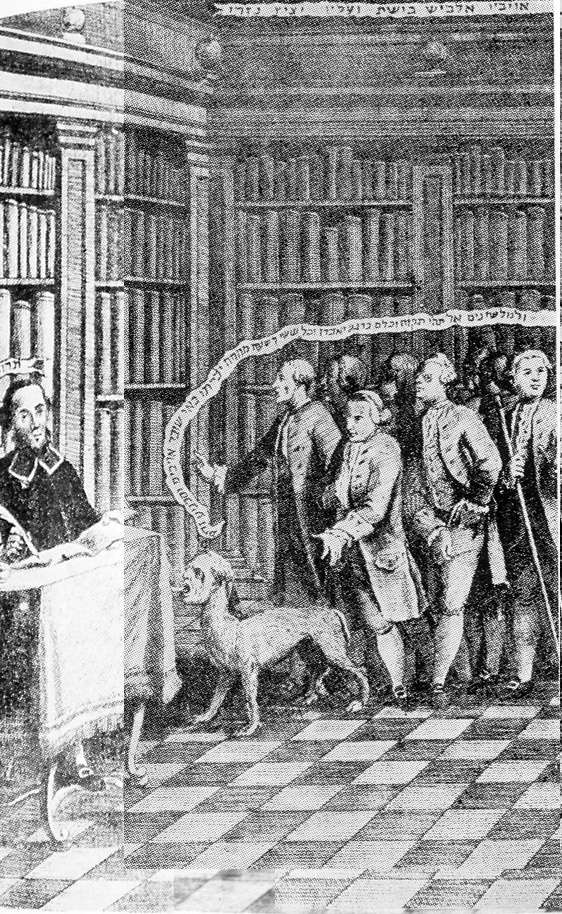
As you can see, here is an apparently pious and learned man seated with his seforim, being confronted by a gang led by a man with a dog's body (or is that a dog with a man's head?). There are some choice biblical (Psalm 132:18; Micah 5:8) and liturgical (link) quotes.
The background that I am aware of is as follows. This particular image was engraved in 1777, possibly by the man depicted himself. His enemies are the communal leaders of Modena, and he obviously got his pictorial revenge. Although there may be other sources which describe the circumstances (eg, in Modena communal records perhaps?) the only primary source I'm aware of comes about through a fortuitous coincidence someone told the Chida about it while he was staying in Trieste in March of 1777, where he also met the man. On pg. 88 in the Ma'agal Tov Ha-shalem we see:
Chida writes (from Trieste) that
"The aforementioned Signore Samson [Levi] told me about the "plague of the beard," Signor Zecharia Padova, whom the leaders of Modena ordered to remove his beard because he was "suspected" and was causing a chillul Hashem (profanation of God's name) and they shaved it off. He left there cursing them and with a caricature that he made, of himself as a rabbi studying, and the officials of Modena, one of them with the head of a dog and the rest appearing like boors. At night I spoke with him, reproached him a great deal, but he remained rebellious. May God allow him to repent for the honor of his rabbinic ancestors." Thus we know what the circumstances of this very interesting caricature are, even if we do not have very specific details.In Benjamin Cymerman's English translation of Ma'agal Tov he footnotes that "He is clearly a dubious character and would shame the community," which I suppose is the only conclusion one can draw from this passage. Of course we realize that Zecharia Padova did not see it that way, quite the opposite; I do not know who is right in this dispute. It should also be noted that without further information it isn't even possible to conclude that the communal leaders over-reacted. In that very year, 1777, the Jews were expelled from all territory of the Republic of Venice (link). While it's obviously too much to lay unspecified bad behavior on the part of one individual as imperiling the entire community, especially when we do not know if this was even claimed on the part of the officials, we would do well to recall at least that 1777 wasn't 1977, even in Italy. Thus, the chillul Hashem of a rabbi-appearing Jew may well have come with dire consequences.
I don't know how many copies of this picture were distributed or how many survive, but this particular copy was in Cecil Roth's personal collection and he printed at least two times. The first appeared in the the pre-Hitler Encylopedia Judaica [1]. Roth had sent the editors the image but to his dismay they completely messed up the caption. Writing in the 1940s, Roth said that "as it happens, this caricature — a unique copy, probably, of a unique production — is to be found in my collection, answering in every detail to Azulai's description. When the Encyclopaedia Judaica was in the course of publication, I sent it to the Editors for reproduction. To my amazement, they described it (volume ix, c. 967-8) as a caricature on the English "Jew Bill" of 1753, thus depriving it completely of its significance. I am happy to have this opportunity of clearing up the confusion." [2]
Below is how it appeared in the Encylopedia Judaica:
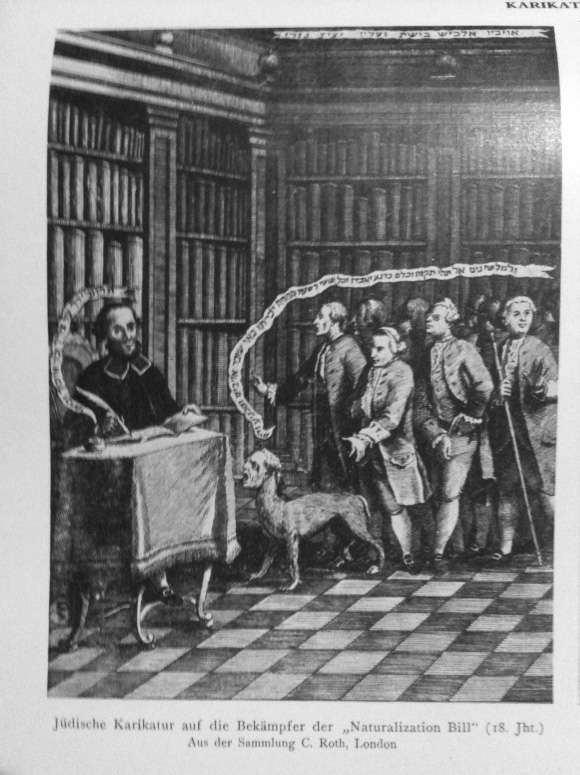
Here is how Roth described the image: "The great Azulai, in his travel-diary Maagal Tob (p. 88) mentions how in 1777, when he was in Trieste, he heard about the dispute in which this person had been involved with the leaders of the community of Modena, and how in revenge he had distributed far and wide a caricature shewing himself as a Rabbi, sitting at his desk and writing, and his enemies looking like boors, one of them in the semblance of a dog. " I want to include another comment by Roth, because it shows his humility. Anyone who will go on record admitting that he doesn't understand something and asks for help is deserving of recognition for it. Roth adds: "(I may mention that Azulai's allusive method renders parts of the passage unintelligible, and that I would be most grateful for any assistance in interpreting it.)"
Taking Roth up on the challenge, another writer writes that he doesn't believe the Chida meant to say that Zechariah Padova made the image himself. "Azulai uses the verb עשה which can mean not only to make something but also to have something made. It is more likely that the Rabbi would have gotten others to compose the caricature than that he would do it himself. The caricature is a copper engraving the execution of which must have required considerable acquaintance with the subject." [3] While he is probably right about that, he refers to the subject of this post as "Rabbi Zechariah Padova" and "Rabbi Zechariah" and "the Rabbi."
In a book edited by Roth in 1961 called "Jewish Art, an Illustrated History" once again this image is printed (pg. 522) in an article by Roth himself called "Jewish Art and Artists Before Emancipation." Evidently Roth did not accept this clarification, for he writes (pg. 521) "In 1777, a scholar from Modena in Italy, Zechariah Padova, after a quarrel with the leaders of his community, caricatured them in an etching, in which he depicted himself seated in his study and his elegantly-dressed opponents advancing on him, one of them — his bitterest enemy — having a dog's body. The artist's self-portrait is noteworthy." In the next paragraph he calls this an "unusual achievement."
It is true that Roth never calls him a rabbi, but Lansberger did, and I was naturally curious about his identity. Let me tell you, there isn't a lot out there about Zechariah Padova.
In a remarkable little book which essentially lists any and all Italian rabbis through the ages called Indice alfabetico dei rabbini e scrittori israeliti di cose giudaiche in Italia (1886) by Rabbi Marco Mortara we find the following entries for rabbis surnamed Padova; thus we see that he was not a rabbi:
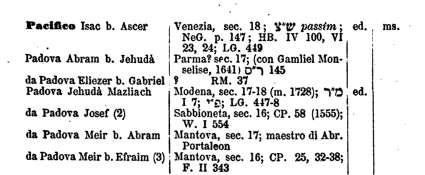
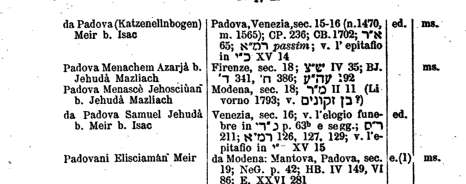
Here is the title page of that book:
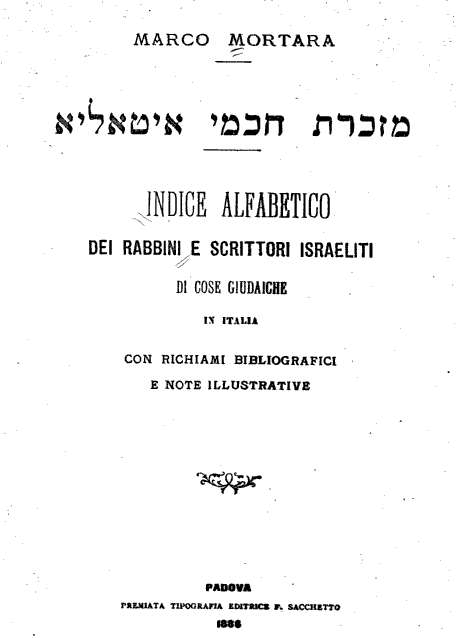
The only possible reference I found to our Zecharia Padova is the following in the 4th volume of the Mekize Nirdamim Society's Kovetz al Yad series (1888). This particular volume published documents relating to the Ten Tribes by Adolph Neubaeur:

As you can see in Mortara's book, one of the Rabbis Padova was Rabbi Menashe Padova of Modena (d. 1793), or Menasce Jehosciuan Padova in the charming Italian orthography. If this Zechariah Chaim Padova, the grandson of Rabbi Menashe Padova, is the same man then we've seen what the Chida was talking about; he was part of a distinguished rabbinic family, and the Chida felt that he was defaming his family. If only we knew what he was accused of!
[1] I guess a lot of people don't realize that Encylopedia Judaica was originally begun in Germany (and naturally, in German). Ten volumes were published (Aach to Lyra) between 1928 and 1934 until the project had to be abandoned. The publisher Nachum Goldmann was instrumental in reviving the project in 1966, and the fruits were the Encylopedia Judaica, edited by Cecil Roth, which many of us know and love (completed in 1972). This complete EJ even included some articles translated from the original German edition. My thanks to Dan Rabinowitz for providing me with the page from the Encyclopedia Judaica.
[2] Roth, Cecil "New notes on pre-emancipation Jewish artists" pg. 506 in HUCA 17 (1942)
[3] Landsberger, Franz "New studies in early Jewish artists " pg. 301 HUCA 18 (1944). I am happy to send these two articles to all who email me and ask.


S., would you recommend the English translation of Ma'agal Tov as "pleasure reading" for someone interested in Jewish history and travel literature in general?
ReplyDeleteThe public library here doesn't have it so I'd have to order it from somewhere, at some expense.
Yes, but with the caveat that it is difficult reading. Cymerman's translation is a little . . . odd in certain respects. In addition, a lot of it is lists of names and places. The Chida didn't write it (it seems) for publication and it isn't written in a pleasing narrative form. However there are dozens if not hundreds of gems scattered throughout it, and it can be a lot of fun to read it and find them. Cymerman did a good job, but he left a lot of room for really expanding on the people and places and things the Chida writes about. For example, I'm going to do another post later about two lines in the Ma'agal Tov, which Cymerman only gave the slightest explanation for. You could have done several dense paragraphs about those two lines.
ReplyDeleteI was only able to see it for sale online for something like $70 (checked addall.com). I would not pay that for it (and I didn't). Better to wait for a cheaper copy to appear eventually.
I've seen a few places list it for less -- around $30-$35...
ReplyDeletehttp://nehora.com/index.cfm/product/1137/the-diaries-of-rabbi-haim-yosef-david-azulai-chidah.cfm
http://www.judaism.com/display.asp?etn=HDCCH
Not sure if they are legit.
My reading list is kind of long these days so maybe this shouldn't automatically go to the top.
Sure they're legit; as long as they're in stock.
ReplyDeleteI agree, it shouldn't be at the top unless you've got a particular interest. It certainly should be in the "To Own - Eventually" list.
On the subject of Cecil, his wife Irene wrote a posthumous biography of him entitled, "Historian Without Tears". I assume you're already familiar with the book but in the event that you have yet to read it I'd recommend that you give it a shot. It really is fantastic. I expected it to be a book about his aloof professionalism (what else could "without tears" mean?) but it was precisely the opposite and provides a bay window into the world of a brilliant and passionate Jewish historian during one of the most important periods in Jewish history.
ReplyDeleteMoshe Rudner
It is indeed a great book. One thing which made Roth so great was precisely how he never removes his personality from what he is talking about.
ReplyDeleteWhile on this somewhat related topic:
ReplyDeleteAre you aware of anyplace where the Chida might refer to having encountered any "herbs of happiness" which were ingested by means of smoking?
Interesting nusach for the 19th blessing in the picture.
ReplyDeleteDF
I assume this is the same as the Zecharia Hayyim ben Eliezer Padova who copied a 28 page pamphlet of Sabbatian literature in 1755 (ms available in the Warsaw Jewish Historcial Institute). At the time he identified himself as from the city (province?) of Vercelli but by 1757 when he wrote some piyyutim in a collection he was already in Modena. His father may be the same R. Eliezer Padova whose teshuva is recorded in another ms among respectable/non-Sabbatian meshivim.
ReplyDeleteWhether the incident in 1777 had anything to do with Sabbatian leanings or not, I leave to others.
Yisrael Dubitsky
Bar Uryan
ReplyDeleteThere are a few references to smoking, including the Chida himself, but I don't recall anything that explicit, although in my opinion the last one is closest to anything even remotely like it. For the smoking references, see pp 2, 53, 56, 80, 141, 158 in the MT Ha-shalem, link below (note these are page numbers in the book, not in the pdf)
http://www.hebrewbooks.org/21838
Chashad usually means having relations with someone forbidden [non jewish would be my first guess].
ReplyDeleteRegarding who was right, the Chida clearly felt Zecharia was in the wrong because the Chida rebuked him.
The Chida did not note people who praised him "because he was human"
Thank you for another great post.
ReplyDeleteI referenced this post (with full credit and a link) on my blog Frum Follies. My post, "Shave the Hypocrite" goes after those who vainly protest the innocence of convicted molesters because they have the beard and garb instead of demanding these hypocrites surrender their false claims of piety. http://wp.me/sFbfD-shave
Thanks Yerachmiel.
ReplyDeleteHowever, as some of your commentators note, for this sort of reaction to be even considered as desirable relies on an assumption of a whole lot of justice and lack of corruption on the part of leaders and their hangers-on/ minders. In addition, beards grow back and clothes can be put on again. If Community A perceives a guy as only Community A's problem, until he's gone and in a new community with a whole new beard, they're mistaken. When a guy with a beard in Monsey does something shady, he gives guys in Boro Park with a beard a bad name. In short, this is all no solution, even assuming good will and careful justice on the part of leaders. Also note how the leaders of Modena looked in my piece; their problem was that this fellow was misbehaving (perhaps some Sabbatean connection as per the learned Yisrael Dubitsky above) and he held himself as a rabbi rather than a regular guy. In the Yeshivish/ Chassidish community, there are no differences in dress between rabbi and layman which are discernible to outsiders.
Taking note of the points you make about Yerachmiel's idea, I would still argue that what is needed in the Torah world is for leaders to FIGURATIVELY shave off people's beards who are acting pious and are bringing shame and humiliation on our people and causing a desecration of G-d's name.
ReplyDeleteThe Pope has been called on to defrock pedophile priests.
Lehavdil, Rav Eliezer Silver, Z"TL said that pedophiles in our community should be placed in cherem and not allowed in any shul.
Why is it that in today's climate, men who do not give their wives Gittin have their names posted weekly in the Jewish Press as Mesarev Ladin, but known child molesters, even convicted ones, are allowed to parade around as ehrlich Jews covered up for by our leaders?
I fear you're calling for the wolves to save the sheep The Catholic Church too had this problem: how is it that this most holiest of groups, God's very representative on earth, not only has degenerates among them, but sexual degenerates? The answer was: no we don't. I should think from a frumme POV the thinking would have been "chasdei Hashem! It is our good fortune that we had 10 years of warning from the Catholic Church to think about how we might respond to a similar scandal," but evidently the response is largely the same. One wonders if there even can be any response from God's very representatives on earth besides for "it's all a lie."
ReplyDeleteI wasn't literally proposing forcible shaving as a solution to child molesting. The effective modern equivalent is legal action that puts the culprit on a sex offender's registry.
ReplyDeleteI was merely making the point that we should stop judging by appearances of religiosity and instead publicly condemn those with the chutzpah to pretend to piety inconsistent with their base acts.
Apparently my source confused Chida with Yaakov Sapir.
ReplyDelete